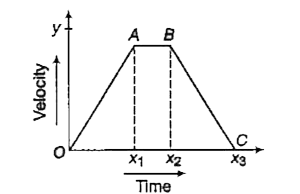Velocity time graph #!#Acceleration through velocity time graph #!#Displacement through velocity time graph
Step by step video solution for Velocity time graph #!#Acceleration through velocity time graph #!#Displacement through velocity time graph by Physics experts to help you in doubts & scoring excellent marks in Class 11 exams.
Updated on:21/07/2023Similar Questions
Graphs are very useful to represent a physical situation. Various quantities can be easily represented on graphs and other quantites can be determined from the graph. For example the slope of velocity-time graph represents instantaneous acceleration. For a motion with constant acceleration slope of velocity-time graph is constant. If acceleration is changing with time, slope with change and thus velocity-time graph will be a non-linear curve. Further the area of velocity-time graph gives displacement.
For the given velocity-time graph the possibly correct acceleration-time relationship is

View SolutionGraphs are very useful to represent a physical situation. Various quantities can be easily represented on graphs and other quantites can be determined from the graph. For example the slope of velocity-time graph represents instantaneous acceleration. For a motion with constant acceleration slope of velocity-time graph is constant. If acceleration is changing with time, slope with change and thus velocity-time graph will be a non-linear curve. Further the area of velocity-time graph gives displacement.
For the given velocity-time graph the fisplacement of the object vetween t = 2 s to t = 4 s is

View Solution
Knowledge Check
In relation to a velocity-time graph
Athe curve can be a circleBthe area under the curve and above the time axis between any two instants gives the average acceleration.Cthe slope at any instant gives the rate of change of acceleration at that instantDthe area under the curve and above the time axis gives the displacement.The figure denotes velocity-time graph, displace ment is equal to
 Ay(x1+x2+x3)By(x3−x1)Cy(x3−x2−x1)Dy2(x3+x2−x1)
Ay(x1+x2+x3)By(x3−x1)Cy(x3−x2−x1)Dy2(x3+x2−x1)The figure denotes velocity-time graph, displace ment is equal to
 Ay(x1+x2+x3)By(x3−x1)Cy(x3−x2−x1)Dy2(x3+x2−x1)
Ay(x1+x2+x3)By(x3−x1)Cy(x3−x2−x1)Dy2(x3+x2−x1)
Graphs are very useful to represent a physical situation. Various quantities can be easily represented on graphs and other quantites can be determined from the graph. For example the slope of velocity-time graph represents instantaneous acceleration. For a motion with constant acceleration slope of velocity-time graph is constant. If acceleration is changing with time, slope with change and thus velocity-time graph will be a non-linear curve. Further the area of velocity-time graph gives displacement.
The velocity-time graph for two objects P and Q are shown. The ratio of their respective acceleration is

View Solution" Find corresponding velocity - time graph for given displacement-time graph "
View Solution[" The acceleration of a "],[" moving body can be found "],[" from "],[" (A) Area under velocity - time graph "],[" (B) Area under distance - time graph "],[" (C) Slope of the velocity - time graph "],[" (D) Slope of distance - time graph "]
View SolutionDraw velocity – time graph of uniformly accelerated motion in one dimension. From the velocity – time graph of uniform accelerated motion, deduce the equations of motion in distance and time.
View SolutionGraphs are very useful to represent a physical situation. Various quantities can be easily represented on graphs and other quantites can be determined from the graph. For example the slope of velocity-time graph represents instantaneous acceleration. For a motion with constant acceleration slope of velocity-time graph is constant. If acceleration is changing with time, slope with change and thus velocity-time graph will be a non-linear curve. Further the area of velocity-time graph gives displacement.
The average velocity of the car for the entire trip is
View Solution
